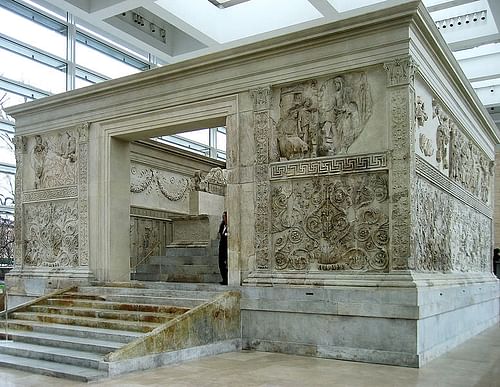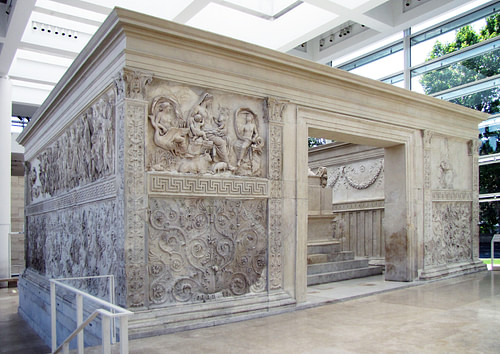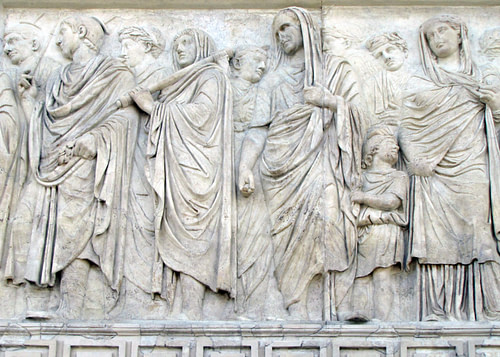How Does the Art of the Ara Pacis Augstae
Commodity
![]() Listen to this article
Listen to this article
The Ara Pacis Augustae or Altar of the Augustan Peace in Rome was congenital to celebrate the render of Augustus in 13 BCE from his campaigns in Spain and Gaul. The marble structure, which once stood on the Campus Martius, is a masterpiece of Roman sculpture and, in item, of portraiture. Senators, officials and the Regal family are depicted on the wall reliefs of the monument in an blithe procession, perhaps, the very procession which consecrated the chantry site on 4th July thirteen BCE or the celebratory procession to welcome the emperor's return.

Ara Pacis Augustae
Voted for by the Senate in thirteen BCE the monument was completed within four years using Italian Luna marble and dedicated on 30th January 9 BCE. The construction has a central altar prepare on a podium surrounded by high walls (11.6 x 10.6 m) composed of large rectangular slabs. There are 2 entrances, one on the due east and the other on the west (back) side, the latter having a short flight of steps due to the lower footing elevation on that side in its original position.
The 3 m tall chantry itself stands on a six 10 7 m podium & has relief scenes depicting Vestal Virgins, priests & sacrificial animals.
The 3 m alpine altar itself stands on a half dozen x 7 m podium and has relief scenes depicting Vestal Virgins, priests and sacrificial animals. The interior sculpture of the surrounding walls depicts fruit and flower garlands hanging from ox heads (bucrania) above fluting. The lower portion of the exterior walls has richly sculpted acanthus scrolls whilst the upper portions behave relief figures. The cornice of the surrounding wall is a modern addition and is, therefore, plain whereas the original cornice would accept been highly decorative with palmettes at each corner. The whole structure, including the reliefs, would take been richly painted and have had touches of gilding.

South Side, Ara Pacis
On the east and west sides of the exterior walls are panels with mythological scenes including a version of the she-wolf nursing Romulus and Remus, Roma seated on a pile of armour flanked by Honos and Virtus, Aeneas sacrificing to the Penates and a female figure with ii children who may be Pax, Venus Genetrix or Tellus (Mother Earth).
The relief figures on the north and south exterior walls are bundled in two groups. On the south side are Augustus and the Imperial family. On the north side are officials such as magistrates, senators, priests and their families. All are captured in a single moment every bit they participate in a procession. Some figures are speaking to each other, one figure (mayhap Augustus' sister) holds a finger to her lips and calls for silence whilst elsewhere some children look incomparably bored with one pocket-sized child pulling the toga of an adult in order to be picked upwards. The animation and individuality of the figures is a high signal of Roman sculpture and the relief is besides graded to requite the scene depth and a further reality.

Procession Relief, Ara Pacis
Interestingly, although Augustus is nowadays in the scene, the emperor is actually not and then easy to choice out, which is in dandy contrast to later Royal sculpture where the emperor of the fourth dimension is very much the focal bespeak of the monument. As Charles Wheeler stated, 'If we would empathise the Augustan period - its repose proficient manners and its undemonstrative conviction - in a unmarried document, that document is the Ara Pacis Augustae.'
The altar came to stand for Pax (Peace), a concept specially forwarded during the reign of Augustus and it was probably for this reason that the Ara Pacis appeared on the coins of Nero between 64 and 67 CE. Diverse pieces of the altar were re-discovered c. 1568, 1859 and 1903 CE and a more than concerted excavation of the site was carried out betwixt 1937 and 1938 CE. The hundreds of altar fragments, which had been dispersed across several European museums, were collected together and the altar reassembled. Largely consummate, the altar at present stands in the purpose built Museo dell'Ara Pacis, an elegant glass and stone structure side by side to the Mausoleum of Augustus in Rome.
This article has been reviewed for accurateness, reliability and adherence to bookish standards prior to publication.
Bibliography
- Museo dell'Ara PacisAccessed 1 Dec 2016.
- Claridge, A. Rome. Oxford University Printing, United states of america, 2010.
- Henig, One thousand. A Handbook of Roman Fine art. Phaidon Press Ltd, 1983.
- Hornblower, S. The Oxford Classical Lexicon. Oxford University Printing, USA, 2012.
- Masi, S. Rome & The Vatican. Bonechi, Florence, 2002
- Wheeler, Thousand. Roman Fine art and Architecture. Thames & Hudson, 1985.
Translations
We want people all over the world to acquire about history. Assistance united states of america and translate this article into some other linguistic communication! And so far, we take translated it to: Castilian
About the Author
Marker is a history writer based in Italia. His special interests include pottery, compages, world mythology and discovering the ideas that all civilizations share in common. He holds an MA in Political Philosophy and is the Publishing Director at WHE.
Gratuitous for the World, Supported by Y'all
World History Encyclopedia is a non-profit organisation. For but $v per month you can get a member and support our mission to engage people with cultural heritage and to meliorate history education worldwide.
Get a Fellow member Donate
Recommended Books
-

$36.00
-

$13.56
-

$21.95
-

$x.97
Cite This Work
APA Style
Cartwright, K. (2013, October 13). Ara Pacis Augustae. Earth History Encyclopedia. Retrieved from https://www.worldhistory.org/commodity/618/ara-pacis-augustae/
Chicago Style
Cartwright, Mark. "Ara Pacis Augustae." Earth History Encyclopedia. Last modified October 13, 2013. https://world wide web.worldhistory.org/article/618/ara-pacis-augustae/.
MLA Style
Cartwright, Marker. "Ara Pacis Augustae." Earth History Encyclopedia. World History Encyclopedia, xiii Oct 2013. Web. 01 May 2022.
Source: https://www.worldhistory.org/article/618/ara-pacis-augustae/
0 Response to "How Does the Art of the Ara Pacis Augstae"
Post a Comment